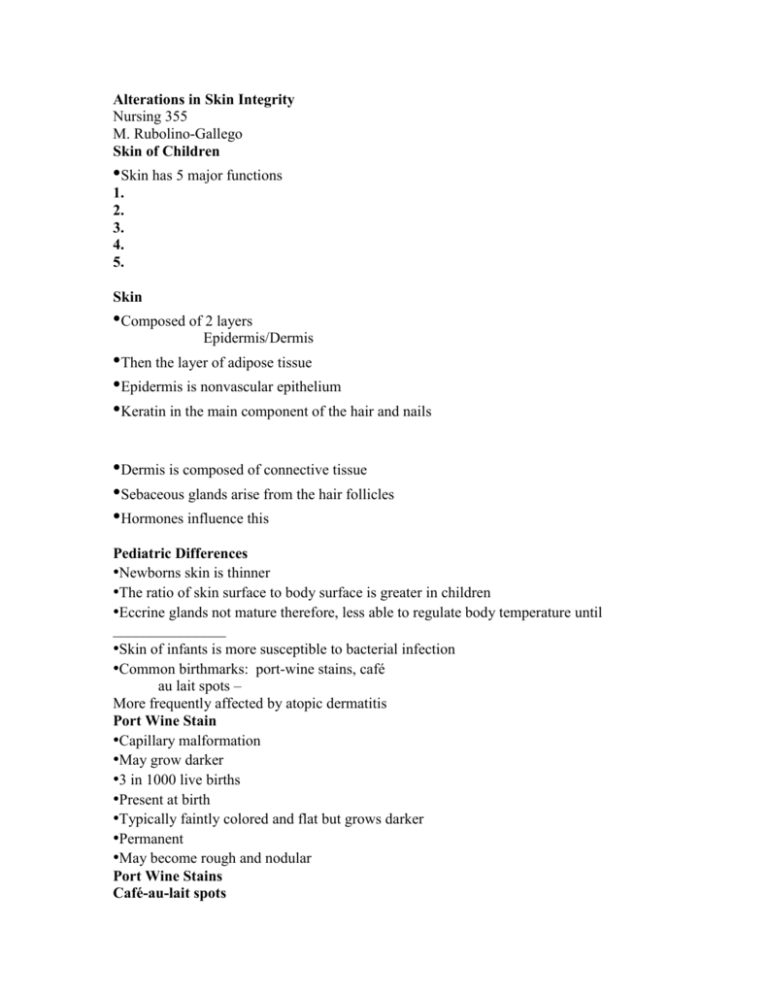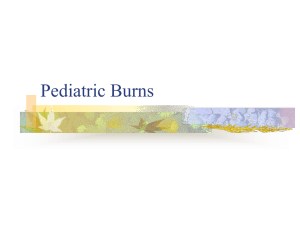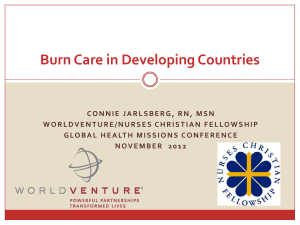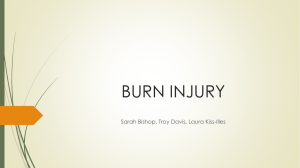Alterations in Skin Integrity
advertisement

Alterations in Skin Integrity Nursing 355 M. Rubolino-Gallego Skin of Children •Skin has 5 major functions 1. 2. 3. 4. 5. Skin •Composed of 2 layers Epidermis/Dermis •Then the layer of adipose tissue •Epidermis is nonvascular epithelium •Keratin in the main component of the hair and nails •Dermis is composed of connective tissue •Sebaceous glands arise from the hair follicles •Hormones influence this Pediatric Differences •Newborns skin is thinner •The ratio of skin surface to body surface is greater in children •Eccrine glands not mature therefore, less able to regulate body temperature until _______________ •Skin of infants is more susceptible to bacterial infection •Common birthmarks: port-wine stains, café au lait spots – More frequently affected by atopic dermatitis Port Wine Stain •Capillary malformation •May grow darker •3 in 1000 live births •Present at birth •Typically faintly colored and flat but grows darker •Permanent •May become rough and nodular Port Wine Stains Café-au-lait spots •Light brown pigmented areas •Can appear anywhere on the body •Having ____ or more of these lesions, if larger than 5 mm in diameter, suggest neurofibromatosis Café-au-lait spots Mongolian Spots •Not vascular •Pigmentation deep in the dermis •90% of AA and Native American baby’s have this •Present at birth •Fade completely by _____ years old Mongolian Spots Hemangiomas •Proliferating dilated capillaries •2.5% of all newborns have this •Typically not visible at birth •Grow during the first year •Usually regress spontaneously after 1 year of age and gone by 5 or 6 Hemangiomas Salmon Patch •Most common •Stork bites, angel kisses •Benign •Typically fade •May become darker when child is crying Salmon Patch Stork Bite Birthmarks •20-40% of newborns •Laser only if obstructing nares,eyes… Wounds •Structural or physiologic destruction of the integument •2 types: Chronic and Acute •Acute - _________________________ •Chronic – ____________________________ •Healing process: the defect is filled by a blood clot and necrotic debris, which will dehydrate the tissue •Heal by migration and proliferation •Cell migration ceases when migrating cells make contact with epithelial cells •Fixed basal cells near the wound begin to divide rapidly to replace the migrated cells •The migrated cells will then begin to divide and thicken •The first cell advances, anchors, and then stops moving. Other cells advance over it. •With deeper injuries: inflammation, fibroplasia, scar contraction, and scar maturation •Factors influencing wound healing: Deficiencies in Vitamin C, Zinc, and protein Stress - releases catecholamines causing vasoconstriction Impair wound circulation Hydrogen peroxide, iodine Infection - increase inflammatory response Fluid accumulation -tissues won’t approximate Radiation-tissue necrosis Diseases - DM, anemia Management of Wound •Dressings: protection, moist environment, provide compression, absorb drainage, control odor, and reduce pain •Types of dressings: Occlusive, semiocclusive and nonocclusive •Topical therapy: corticosteroid therapy, cautery, cyrosurgery, laser, UV therapy •Systemic: Corticosteroids and antibiotics Burns •Higher mortality rate in very young children than older children •Lower burn temperature and shorter exposure to heat/chemicals can cause a more severe burn on a child •________________________________________________________ •Children are at increased risk for protein and calorie deficiency •Immature immune system •Delay in growth following extensive burns •Burn injuries can represent one of the most severe traumas •Fire and burns remain _______________________________________________among children 1-14 years in the US •Another source of burn injury is child abuse (18%) •Girls more susceptible to the ignition of clothing •Children playing with matches account for 1 in 10 house fires (boys age 2-5) •In children younger than 5 years, accidental burns are likely to occur as a result of environmental situations that are not controlled by caretakers Prevention •Fire drills •ID 2 or more exits from each room and a location to meet outside the home •Understand “stop, drop, and roll” •Check smoke detectors •Keep all lighters and matches out of reach •Use of outlet covers •Hot water thermostat down to 120 F •Turn pot handles in (back burners) •Do not set a child in your lab while drinking hot fluid •Keep child away from outdoor grills Causes of Burns •Electrical_______________________________, current disrupts the electrical rhythm of the heart •Follows the path of least resistance through the body - tissue, fluid, blood vessels, nerves •Entering through the skin leaving the affected area without blood supply •Amputation is necessary in more than 90% of children •Greatest damage and entrance and exit sites Thermal •Flame •Hot surfaces •Hot liquids Chemical •Can cause extensive injury •Severity is r/t the chemical agent and duration of contact •Chemical disruption and alteration of the physical properties of the exposed body area •Exposure to eyes, ingestion Pediatric Burns •Burns involving more than _________________ require a form of fluid resuscitation •Increased risk for protein and calorie deficiency because they have smaller muscle mass and lower body fat •Scarring is more severe •Increased risk for infections Burn Classifications First degree (______________________) •minor, tissue damage is minimal, systemic effects are rare, pain is the predominant symptom, burn heals in 3-6 days without scarring •Destroys epidermis •Sunburn •Protective function of the skin remains intact Second degree (__________________________________) •epidermis and dermis, heal in 14 days, sweat glands and hair follicles remain intact, extensive scarring •Wound sensitive to temperature changes •Appears mottled with pink or bright red or waxy white areas, blisters Third degree (_____________________________________) •epidermis, dermis and subq tissue, nerve endings, sweat glands, hair follicles destroyed, as nerve fibers regenerate, painful sensations return •Varies in color from red, to tan, waxy white, brown or black •Dry leathery appearance Extent of Injury •Total body surface area (TBSA) •Rule of nines used only in adults •Infants head and neck make up ________________ •Each lower extremity accounts for _________________ Deep Partial Thickness Burn & Full Thickness Burn Burn Care Severity of Injury •Major burn injury – require the services of a specialized burn center •Moderate burn injury – tx in hospital with expertise in burn care •Minor burn injury – tx on outpatient basis •Determined by the extent and depth of the burn, agent, body area involved, pts age, illnesses Management of Minor Burns •Cleansing wound with mild soap and water •Debridement •Blisters are usually left intact •Cover wound with antimicrobial ointment •Protect it from trauma •Tetanus Hx •Mild analgesic Management of Major Burns •Admitted to hospital •Maintain adequate airway •Initiation of fluid administration •Nutritional support – high-protein, high-calorie •Pain meds –morphine, versed, fentanyl Management of Burn Wound •Prevention of infection •Removal of devitalized tissue •Closure of the wound Removal of Dead Skin and Debris Nursing Considerations •Acute phase – treatment of burn shock and management of pulmonary status •Vital signs, output, fluid infusion, lab data •Check electrolyte balance, respiratory function, cover wound with clean sheets and maintain body temp •Management and rehabilitative phases – •Once stabilized, management phase begins •Preventing wound infections, closing the wound, managing numerous complications that may occur •Rehab phase begins when permanent wound closure begins •Comfort management – reduce anxiety, caregivers involvement Cooking Microwave Safety Impetigo •___________________________________ •Very contagious •Increased risk: daycare, schools, camps •Typically occurs from a secondary lesion from another source (insect bite) •Occurs during hot/humid months Impetigo •S. Aureus, Group A hemolytic strep causes this •Incubation 7-10 days •__________________________________________ •Should not attend school until 24 hours after treatment •Two types: •Bullous •crusted Impetigo •Bullous •Initially filled with serous fluid •Later become pustular •Crusted •Vesicle or a pustule that ruptures to become an erosion •Honey-colored crust •Mildly pruritic Tx: topical/oral antibiotiecs Wash gently 3 times/day Crusted Impetigo Crusted Impetigo Crusted Impetigo Bullous Impetigo Bullous Impetigo Bullous Impetigo Candidiasis •Thrush (oral) •Fungal infection of the oral mucous membranes •Overgrowth of candida albicans •White,curdlike plaques on tongue, gums, buccal mucosa •Tx: nystatin oral suspension (100,00- U/ml) swabbed onto the mucous membranes of mouth •Mother’s paint their nipples with thie prior to nursing Candidiasis Cellulitis Tinea Infections •Superficial skin infection caused by fungi known as dermatophytes •Transmitted person to person, animal contact Tina Capitis •Scalp •Typically ages 1-10 years •Erythema and scaling of the scalp •One or more round patches of alopecia Tinea Cruris •Jock itch •____________________________________ •Groin and scrotal area •Not highly contagious •Poor hygiene and friction from tight clothing •Pink papules and scales on the inner thighs, groin, scrotum and buttocks •pruritus Tinea Pedis •Athlete’s foot •_______________________________ •Contagious •Fine, vesiculopustular or scaly lesions on the soles of the feet, between the toes and unde the nails •Severe pruritus and burning Tinea Corporis •Trunk, vace, and extremities •Ringlike plaques with pale centers and scaly, red margins •_____________________________ Tinea Capitis and Tinea Corporis Tinea Capitus Tinea Pedis Tinea Pedis Tinea Corporis Tinea Cruris Tinea Treatment •Capitis - oral griseofulvin for 6-8 weeks, nizoral or lamisil for children •Coporis - Lotrimin cream or Monistat 3 times/day •Cruris - topical antifungal preparations 2 times/day, loose clothing •Pedis - Lotrimin or Monistat 2 times/day, Sporanox - newer agents Acne Vulgaris Herpes Simplex Virus •Common, contagious, recurrent infection of the skin and mucous membranes •Can be extremely painful •Transmitted by infected body fluids and secretions •Initial HSV 1 infection commonly occurs by the time the child turns 5 years Herpes Treatment •Topical Acyclovir or oral Herpes Simplex Virus Type I Herpes Simplex Lice Infestation •Small, blood-sucking insects •Major problem in schools today •Live only on humans •Cannot jump like fleas •Tx: Kill the active lice and remove nits Pediculosis Capitus Pediculosis Scabies •Contagious condition •Transmitted by close personal contact •_______________________________________________________________________ •Female mite burrows into the epidermis, lays her eggs and dies in the burrow after 4-5 weeks •Cause intense pruritus •Impetigo can occur secondary to scratching •Tx: topical cream (Elimite or Kwell), apply to body and left on 8-14 hours Scabies Scabies Scabies Scabies Atopic Dermatitis •AKA eczema •Common, chronic, allergic, inflammatory disease of the skin •Severe pruritus •Cause unknown •Genetically determined •Dry, sensitive skin, allergies, emotional stress Atopic Dermatitis •50-80% of children with this develop asthma or allergic rhinitis •9-12% of young children •Usually begins in infancy and clears by age 2-3 •Dx: skin testing for food allergies •Tx: control itching and scratching, oral antihistamins, atarax, benadryl, claritin,steroids occasionally Atopic Dermatitis Atopic Dermatitis Atopic Derm Contact Dermatitis •Skin inflammation that results from direct skin-to-irritant contact •Common causes: rubber products, dyes, nickel, plant oils, strong soaps, wool clothing •More common in children •_________________________ •Tx: steroid cream (triamcinolone 0.1%) Contact Dermatitis Contact Dermatitis Seborrheic Dermatitis •Cradle cap •Chronic inflammatory skin condition seen frequently in infants •Begins first 2-3 weeks of life •Usually disappears by 12 months •Non-pruritic, oily, yellow scales that block sweat and sebaceous glands Acne Vulgaris •Disorder of the sebaceous hair follicles •Causes anxiety and emotional pain •85% of adolescents •Closed whiteheads, blackheads, papules, pustules, nodules, cysts •Areas affected: face, neck, back, shoulders, upper chest Acne Vulgaris •Tx goal: prevent scarring •Topical therapy - benzoyl peroxide •Antibiotics: tetracycline, erythromycin •Accutane - suppresses sebum production and sebaceous gland activity •OCPs Acne Vulgaris Acne Vulgaris Acne Vulgaris Insect Bites or Stings •2 million people in the US are severely allergic to venomous stinging insects •Epi pen should be available for these children •Repellents with DEET should not be used on small children (toxic encephalopathy) Arachnids •Not aggressive •Bites only when threatened •Within 2-8 hours will become painful/ erythematous and blister •Venom is necrotic Brown Recluse Spider Bite Poison Ivy/Dermatitis









